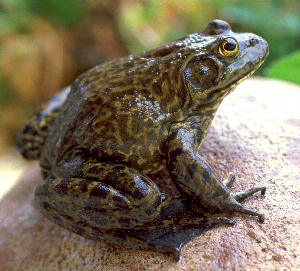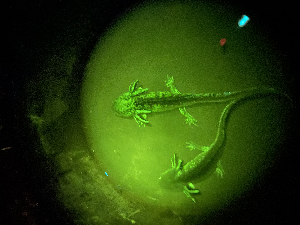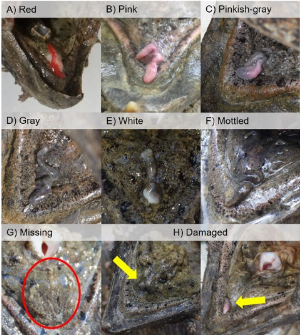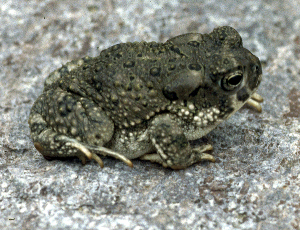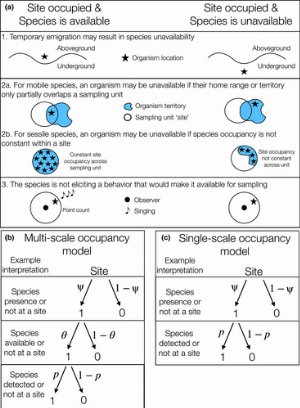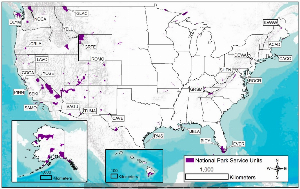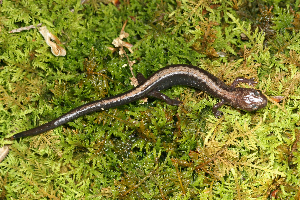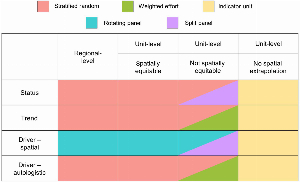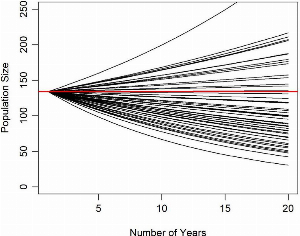Search ARMI Database
Search term(s)
Contribution Number
Search Results
879 record(s) found.
Papers & Reports Invasive bullfrogs maintain MHC polymorphism including alleles associated with chytrid fungal infection
Authors: Jacob LaFond; Katherine R Martin; Hollis Dahn; Jonathan Q Richmond; Robert W Murphy; Njal Rollinson; Anna E Savage
Date: 2022-05-19 | Outlet: Integrative and Comparative Biology 62:262–274
Maintenance of genetic diversity at adaptive loci may facilitate invasions by non-native species by allowing populations to adapt to novel environments, despite the loss of diversity at neutral loci that typically occurs during founder events. To evaluate this prediction, we compared genetic diversity at major histocompatibility complex (MHC) and cytochrome b (cytb) loci from 20 populations of the American bullfrog (Rana catesbeiana) across the invasive and native ranges in North America and quantified the presence of the pathogen Batrachochytrium dendrobatidis (Bd). Compared to native populations, invasive populations had significantly higher Bd prevalence and intensity, significantly higher pairwise MHC and cytb FST, and significantly lower cytb diversity, but maintained similar levels of MHC diversity. The two most common MHC alleles (LiCA_B and Rapi_33) were associated with a significant decreased risk of Bd infection, and we detected positive selection acting on four peptide binding residues. Phylogenetic analysis suggested invasive populations likely arose from a single founding population in the American Midwest with a possible subsequent invasion in the northwest. Overall, our study suggests that the maintenance of diversity at adaptive loci may contribute to invasion success and highlights the importance of quantifying diversity at functional loci to assess the evolutionary potential of invasive populations.
Papers & Reports Biofluorescence in tiger salamanders documented in Rocky Mountain National Park for the first time
Authors: Benjamin Lafrance; Andrew M Ray; Amanda M Kissel; Erin Muths
Date: 2021-12 | Outlet: Park Science
Recent work has shown that many amphibians are biofluorescent. Biofluorescence describes an organism’s ability to absorb visible and ultraviolet light and re-emit it at a lower energy level (e.g., blue light re-emitted as green fluorescence). However, the function of fluorescence in amphibians is unclear. We observed paedomorphic western tiger salamanders at Lily Lake in Rocky Mountain National Park and obtained the first images recorded at this park of biofluorescence in these animals in response to blue light.
Papers & Reports Using physiological conditions to assess current and future habitat use of a Subarctic frog
Authors: Thomas P Hastings; Blake R Hossack; L Fishback; J M Davenport
Date: 2022 | Outlet: Integrative Zoology
Species with especially close dependence on the environment to meet physiological requirements, such as ectotherms, are highly susceptible to the impacts of climate change. Climate change is occurring rapidly in the Subarctic and Arctic, but there is limited knowledge on ectotherm physiology in these landscapes. We investigated how environmental conditions and habitat characteristics influence the physiological conditions and habitat use of wood frogs (Rana sylvatica, LeConte 1825) in a Subarctic landscape near Churchill, Manitoba (Canada). We used plaster models to estimate water loss rates and surface body temperatures among different habitat types and at specific locations used by radio-tracked frogs. Water loss (R^2 = 0.67) and surface temperature (R^2 = 0.80) of plaster models was similar to that of live frogs. Model-based water loss rates were greater in tundra habitat than in boreal forest and ecotone habitat. Habitat use of wood frogs was strongly tied with available surface moisture and decreased water loss rates that were observed with plaster models. Environmental conditions, such as wind speed and ground temperature, explained 58% and 91% of the variation in water balance and temperature of plaster models. Maintaining physiological conditions may be challenging for semi-aquatic ectotherms in environments vulnerable to future climate change. The ability to predict physiological conditions based on environmental conditions, as demonstrated in our study, can help understand how wildlife will respond to climatic changes.
Papers & Reports Testing Assumptions in the Use of PIT Tags to Study Movement of Plethodon Salamanders
Authors: S C Sterrett; T D Dubreiul; M O'Donnell; Adrianne B Brand; Evan HC Grant
Outlet: Journal of Herpetology
Studying the movements of organisms that live underground for at least a portion of their life history is challenging, given
the state of current technology. Passive integrated transponders (PIT tags) provide a way to individually identify and, more recently,
study the movement of smaller animals, including those that make subterranean movements. However, there are widespread
assumptions of the use of PIT tags that remain problematic. We tested the effects of PIT-tag implantation on growth and survival, along
with the effects of electromagnetic fields for reading PIT tags on behavior, of the smallest salamander that has been PIT-tagged: the Red-
Backed Salamander. We found no effect of PIT tags on growth or survival. Using a mesocosm experiment, we also found that
electromagnetic effects associated with reading PIT tags, had no effect on salamander behavior. Further, we describe a novel PIT antenna
and soil mesocosm experimental arena for studying belowground movements of woodland salamanders. Collectively, these studies
suggest that the use of PIT tags do not influence the growth, survival, or behavior of Red-Backed Salamanders. Given the challenges of
studying salamanders that live underground and the impending changes in climate and landscapes, this research suggests that PIT tags
remain a viable tool for studying the movement ecology of salamanders under global change.
the state of current technology. Passive integrated transponders (PIT tags) provide a way to individually identify and, more recently,
study the movement of smaller animals, including those that make subterranean movements. However, there are widespread
assumptions of the use of PIT tags that remain problematic. We tested the effects of PIT-tag implantation on growth and survival, along
with the effects of electromagnetic fields for reading PIT tags on behavior, of the smallest salamander that has been PIT-tagged: the Red-
Backed Salamander. We found no effect of PIT tags on growth or survival. Using a mesocosm experiment, we also found that
electromagnetic effects associated with reading PIT tags, had no effect on salamander behavior. Further, we describe a novel PIT antenna
and soil mesocosm experimental arena for studying belowground movements of woodland salamanders. Collectively, these studies
suggest that the use of PIT tags do not influence the growth, survival, or behavior of Red-Backed Salamanders. Given the challenges of
studying salamanders that live underground and the impending changes in climate and landscapes, this research suggests that PIT tags
remain a viable tool for studying the movement ecology of salamanders under global change.
Papers & Reports Optimizing Survey Design for Shasta Salamanders (Hydromantes spp.) to Estimate Occurrence in Little-Studied Portions of their Range
Authors: Brian J Halstead; Patrick M Kleeman; Graziella V DiRenzo; Jonathan P Rose
Date: 2022-08 | Outlet: Journal of Herpetology
Shasta salamanders (collectively, Hydromantes samweli, H. shastae, and H. wintu; hereafter Shasta salamander) are endemic to northern California in the general vicinity of Shasta Lake reservoir. Although generally associated with limestone, they have repeatedly been found in association with other habitats, calling into question the distribution of the species complex. Further limiting our knowledge of the species’ distributions is that they are only active or available for sampling on the soil surface for a small portion of the year, and detection probabilities for the species have never been estimated. We developed and implemented a survey protocol designed to estimate detection, availability, and occurrence probabilities from December 2019 through March 2020. We provide inference on Shasta salamander occurrence in portions of their range that have received little survey effort. We found that Shasta salamander occurrence was positively associated with the percent cover of embedded rock, and their availability (i.e., probability of being active on the soil surface during sampling) was positively related to relative humidity. The probability of occurrence of Shasta salamanders in our study area was low, and our winter-to-spring survey protocol was effective for estimating detection, availability, and occurrence probabilities in the study area and at specific sites. We suggest that conducting replicate surveys that quantify animal availability and detection probabilities will facilitate a better understanding of the habitat associations of Shasta salamanders and other rare species that might often be unavailable for detection
Papers & Reports Condition and Coloration of Lingual Lures of Alligator Snapping Turtles
Authors: Brad M Glorioso; John L Carr; Carl Franklin; Mandi Gordon; Aaron Johnson; Ethan Kessler; Eric Munscher; Luke S Pearson; Viviana Ricardez; Arron Tuggle
Date: 2023-06-07 | Outlet: Southeastern Naturalist
The lingual lure of Alligator Snapping Turtles, Macrochelys Gray, are believed to be the only prey-capturing lures within the mouths of modern reptiles. To date, no formal assessment of lure condition in Alligator Snapping Turtles has been published, and few researchers record lure data. Herein, we report damaged or missing lures from 25 Alligator Snapping Turtles (7 adults, 18 juveniles) from a sample of more than 2,000 lure assessments in 4 states, indicating this is a rare occurrence. We also describe lingual lure color observed in these assessments and introduce standardized terminology and color categories. We suggest researchers record data on the condition and coloration of the lingual lure to further our understanding of this ecological and evolutionary adaptation.
Papers & Reports Long-term monitoring of a species suite of Ecological Indicators: A coordinated conservation framework for the Greater Yellowstone Ecosystem
Authors: Andrew M Ray; Melanie A Murphy; Blake R Hossack
Date: 2022-03 | Outlet: Ecological Indicators
Introduction piece for a special issue.
Papers & Reports ARMI Scientists Collaborate with NPS on Special Issue Focused on Amphibian and Wetland Conservation in the GYE
Authors: Blake R Hossack
Outlet: ARMI web page
news story
Papers & Reports Range-wide Persistence of the Endangered Arroyo Toad (Anaxyrus californicus) for 20+ Years Following a Prolonged Drought
Authors: C J Hitchcock; Elizabeth A Gallegos; Adam R Backlin; Russell Barabe; Peter H Bloom; Kimberly Boss; Cheryl S Brehme; Christopher W Brown; D R Clark; Elizabeth R Clark; Kevin Cooper; Julie Donnell; Edward L Ervin; Peter Famolaro; Kim M Guilliam; Jacquelyn J Hancock; Nicholas Hess; Steven Howard; Valerie Hubbartt; Patrick Lieske; Robert E Lovich; Tritia Matsuda; Katherin Meyer-Wilkins; Kamarul Muri; Barry Nerhus; J A Nordland; Brock Ortega; Robert H Packard; Ruben Ramirez; Sam C Stewart; S Sweet; M L Warburton; Jeffrey Wells; Ryan Winkleman; Kirsten Winter; Brian Zitt; Robert N Fisher
Date: 2022-03 | Outlet: Ecology and Evolution 12:e8796
Prolonged drought due to climate change has negatively impacted amphibians in southern California, U.S.A. Due to the severity and length of the current drought,
agencies and researchers had growing concern for the persistence of the arroyo toad (Anaxyrus californicus), an endangered endemic amphibian in this region. Range-wide surveys for this species had not been conducted for at least 20 years. In 2017–2020, we conducted collaborative surveys for arroyo toads at historical locations. We surveyed 88 of the 115 total sites having historical records and confirmed that the arroyo toad is currently extant in at least 61 of 88 sites and 20 of 25 historically occupied watersheds. We did not detect toads at almost a third of the surveyed sites but did detect toads at 18 of 19 specific sites delineated in the 1999 Recovery Plan to meet one of four downlisting criteria. Arroyo toads are estimated to live 7–8 years, making populations susceptible to prolonged drought. Drought is estimated to increase in frequency and duration with climate change. Mitigation strategies for drought impacts, invasive aquatic species, altered flow regimes, and other anthropogenic effects could be the most beneficial strategies for toad conservation and may also provide simultaneous benefits to several other native species that share the same habitat.
agencies and researchers had growing concern for the persistence of the arroyo toad (Anaxyrus californicus), an endangered endemic amphibian in this region. Range-wide surveys for this species had not been conducted for at least 20 years. In 2017–2020, we conducted collaborative surveys for arroyo toads at historical locations. We surveyed 88 of the 115 total sites having historical records and confirmed that the arroyo toad is currently extant in at least 61 of 88 sites and 20 of 25 historically occupied watersheds. We did not detect toads at almost a third of the surveyed sites but did detect toads at 18 of 19 specific sites delineated in the 1999 Recovery Plan to meet one of four downlisting criteria. Arroyo toads are estimated to live 7–8 years, making populations susceptible to prolonged drought. Drought is estimated to increase in frequency and duration with climate change. Mitigation strategies for drought impacts, invasive aquatic species, altered flow regimes, and other anthropogenic effects could be the most beneficial strategies for toad conservation and may also provide simultaneous benefits to several other native species that share the same habitat.
Papers & Reports Defining relevant conservation targets for the endangered Southern California distinct population segment of the mountain yellow-Legged frog (Rana muscosa)
Authors: Thierry C Chambert; Adam R Backlin; Elizabeth A Gallegos; Bradd Baskerville-Bridges; Robert N Fisher
Date: 2022-03-02 | Outlet: Conservation Science and Practice 2022;e12666
The endangered mountain yellow-legged frog (Rana muscosa) has been reduced to <10 isolated populations in the wild. Due to frequent catastrophic events (floods, droughts, wildfires), the recent dynamics of these populations have been erratic, making the future of the species highly uncertain. In 2018, a recovery plan was developed to improve the species status by reducing the impacts of various threats (predation, disease, habitat destruction), as well as reinforcing wild populations through the reintroduction of captive-bred frogs. The short-term goal stated in this plan was to reach a minimum of 20 populations of 50 adults each (hereafter, the 20/50 target), before the species can be considered for downlisting from the U.S. Endangered Species Act. However, there is no guarantee that this 20/50 target will be sufficient to ensure the species persistence in the long run. Using 19 years of mark-recapture data, we estimated populations' demographic trends and assessed the viability of R. muscosa from a starting state of 20 populations of 50 adults each (i.e., the downlisting criteria). Our results reveal that, from this 20/50 state, the species has high chances of persistence only at a short time horizon (50 years). Moreover, >80% of populations would be extinct 50 years later. Therefore, the species will not be able to persist without implementation of the reintroduction program. We found that it is more important to increase the number of suitable sites occupied by R. muscosa than to simply reinforce or augment existing populations. Expanding the current distribution by establishing new populations at suitable sites, even after the “20 populations” mark has been reached, would increase the likelihood of the species' persistence in the longer term.
Papers & Reports Ignoring species availability biases occupancy estimates in single-level occupancy models
Authors: Graziella V DiRenzo; David AW Miller; Evan HC Grant
Date: 2022-05-04 | Outlet: Methods in Ecology and Evolution
1. Most applications of single-level occupancy models do not differentiate between availability and detectability, even though species availability is rarely equal to one. The availability process includes elements of species movement, behavior, and phenology, and availability can be estimated using multi-scale occupancy models. However, for the practical application of multi-scale occupancy models, it can be unclear what a robust sampling design looks like and what the statistical properties of the multi-scale and single-level occupancy models are when availability is less than one.
2. Using simulations, we explore the following common questions asked by ecologists during the design phase of a field study: (Q1) what is a robust sampling design for the multi-scale occupancy model when there are a priori expectations of parameter estimates?, (Q2) what is a robust sampling design when we have no expectations of parameter estimates?, and (Q3) can a single-level occupancy model with a random effects term adequately absorb the extra heterogeneity produced when availability is less than one and provide reliable estimates of occupancy probability?.
3. Our results show that there is a tradeoff between the number of sites and surveys needed to achieve a specified level of acceptable error for occupancy estimates using the multi-scale occupancy model. We also document that when species availability is low (< https://0.40 on the probability scale), then single-level occupancy models severely underestimate occupancy by as much as https://0.40 on the probability scale, produce overly precise estimates, and provide poor parameter coverage. This pattern was observed when a random effects term was and was not included in the single-level occupancy model, suggesting that adding a random-effects term does not adequately absorb the extra heterogeneity produced by the availability process. In contrast, when species availability was high (> 0.60), single-level occupancy models performed similarly to the multi-scale occupancy model.
4. As a companion, we provide an RShiny app that allows users to further explore our results and determine optimal designs across different sampling scenarios https://gdirenzo.shinyapps.io/multi-scale-occ/. Our results suggest that unaccounted for availability can lead to underestimating species distributions using single-level occupancy models, which can have large implications on ecological inference and predictions for practitioners, such as those working at the front lines of invasion ecology, disease emergence, and species conservation.
2. Using simulations, we explore the following common questions asked by ecologists during the design phase of a field study: (Q1) what is a robust sampling design for the multi-scale occupancy model when there are a priori expectations of parameter estimates?, (Q2) what is a robust sampling design when we have no expectations of parameter estimates?, and (Q3) can a single-level occupancy model with a random effects term adequately absorb the extra heterogeneity produced when availability is less than one and provide reliable estimates of occupancy probability?.
3. Our results show that there is a tradeoff between the number of sites and surveys needed to achieve a specified level of acceptable error for occupancy estimates using the multi-scale occupancy model. We also document that when species availability is low (< https://0.40 on the probability scale), then single-level occupancy models severely underestimate occupancy by as much as https://0.40 on the probability scale, produce overly precise estimates, and provide poor parameter coverage. This pattern was observed when a random effects term was and was not included in the single-level occupancy model, suggesting that adding a random-effects term does not adequately absorb the extra heterogeneity produced by the availability process. In contrast, when species availability was high (> 0.60), single-level occupancy models performed similarly to the multi-scale occupancy model.
4. As a companion, we provide an RShiny app that allows users to further explore our results and determine optimal designs across different sampling scenarios https://gdirenzo.shinyapps.io/multi-scale-occ/. Our results suggest that unaccounted for availability can lead to underestimating species distributions using single-level occupancy models, which can have large implications on ecological inference and predictions for practitioners, such as those working at the front lines of invasion ecology, disease emergence, and species conservation.
Papers & Reports Looking ahead, guided by the past: The role of U.S. national parks in amphibian research and conservation
Authors: Brian J Halstead; Andrew M Ray; Erin Muths; Evan HC Grant; Rob L Grasso; Michael J Adams; Katy S Delaney; Jane Carlson; Blake R Hossack
Date: 2022-03 | Outlet: Ecological Indicators
Protected areas like national parks are essential elements of conservation because they limit human influence on the landscape, which protects biodiversity and ecosystem function. The role of national parks in conservation, however, often goes far beyond limiting human influence. The U.S. National Park Service and its system of land units contribute substantively to conservation by providing protected lands where researchers can document trends in species distributions and abundances, examine characteristics important for generating these trends, and identify and implement conservation strategies to preserve biodiversity. We reviewed the contribution of U.S. national parks to amphibian research and conservation and highlight important challenges and findings in several key areas. First, U.S. national parks were instrumental in providing strong support that amphibian declines were real and unlikely to be simply a consequence of habitat loss. Second, research in U.S. national parks provided evidence against certain hypothesized causes of decline, like UV-B radiation, and evidence for others, such as introduced species and disease. However, describing declines and identifying causes contributes to conservation only if it leads to management; importantly, U.S. national parks have implemented many conservation strategies and evaluated their effectiveness in recovering robust amphibian populations. Among these, removal of invasive species, especially fishes; conservation translocations; and habitat creation and enhancement stand out as examples of successful conservation strategies with broad applicability. Successful management for amphibians is additionally complicated by competing mandates and stakeholder interests; for example, past emphasis on increasing visitor enjoyment by introducing fish to formerly fishless lakes had devastating consequences for many amphibians. Other potential conflicts with amphibian conservation include increasing development, increased risk of introductions of disease and exotic species with increased visitation, and road mortality. Decision science and leveraging partnerships have proven to be key components of effective conservation under conflicting mandates in national parks. As resource managers grapple with large-scale drivers that are outside local control, public-private partnerships and adaptive strategies are increasing in importance. U.S. national parks have played an important role in many aspects of identifying and ameliorating the amphibian decline crisis and will continue to be essential for the conservation of amphibians in the future.
Papers & Reports Monitoring the status and trends of the Shenandoah salamander in Shenandoah National Park
Authors: Evan HC Grant; Adrianne B Brand; John EB Wofford
Date: 2021-02-01 | Outlet: National Park Service
The Shenandoah salamander (Plethodon shenandoah) is a federally endangered salamander whose distribution is restricted to three mountain peaks within Shenandoah National Park . During the ranking of vital signs monitoring priorities for SHEN, “Federal Threatened and Endangered Species” received the 2nd highest ranking for terrestrial vital signs because of ecological, management, and policy criteria. The following protocol describes the objectives and methods for monitoring the Shenandoah salamander. Because the range size and habitat occupancy are of principle interest, this protocol generates data suitable for estimating the annual proportion of occupied habitat across the species range. Objectives focus on describing the status and trends of the species distribution (i.e. spatial extent) and the proportion of the range that is occupied (i.e. density of occupied sites). To do so, monitoring sites in the core and the edge of the known range are surveyed for salamanders multiple times during both the spring and fall. The resulting data not only allow for an assessment of the status and trend of the species but also provide supporting data to assist in understanding causal drivers of population change.
Papers & Reports Identifying factors linked with persistence of reintroduced populations: lessons learned from 25 years of amphibian translocations
Authors: Blake R Hossack
Date: 2022 | Outlet: Global Ecology and Conservation
Most translocation efforts are unsuccessful, often for unknown reasons. We assessed factors linked with population persistence for 25 years of translocations of the federally threatened Chiricahua Leopard Frog. Local features were paramount, including habitat, predators, and restoration history. Timing and life stages stocked affected persistence, but rearing environment did not. Two or more translocations produced an approximate 4-yr increase in predicted population persistence.
Papers & Reports Energy-related wastewater contamination alters microbial communities of sediment, water, and amphibian skin
Authors: Brian J Tornabene; Kelly L Smalling; C E Givens; Emily B Oja; Blake R Hossack
Date: 2023-07-01 | Outlet: Science of the Total Environment
To inform responsible energy development, it is important to understand the ecological effects of contamination events. Wastewaters from oil and gas extraction often contain high concentrations of sodium chloride (NaCl) and heavy metals (e.g., strontium and vanadium), but studies of their influence on microbial communities are limited. We sampled water, sediment, and larval amphibian skin (four species) across a gradient of contamination (0.04–17500 mg/L Cl) in a large energy production area of North America. NaCl concentrations affected the similarity among microbiomes of water, sediment, and amphibian skin, but not the diversity or richness of water and skin microbiomes. Strontium concentrations were associated with lower diversity and richness of sediment microbial communities. Amphibian microbiomes were similar to those of water, but not sediment, and sediment microbiomes were similar to those of water. Species identity was the strongest predictor of amphibian microbiomes; frog microbiomes were similar but differed from that of the salamander, whose microbiome had the lowest richness and diversity. Understanding whether effects of wastewaters on microbial communities also influences their ecosystem function will be an important next step. Our study provides novel insight into associations among different wetland microbial communities and effects of wastewaters from energy production.
Papers & Reports A comparison of monitoring designs to assess wildlife community parameters across spatial scales
Authors: Alexander D Wright; Evan HC Grant; E F Zipkin
Outlet: Ecological Applications
Dedicated long-term monitoring at appropriate spatial and temporal scales is necessary to develop effective conservation plans. Using an amphibian monitoring program for a network of U.S. National Parks, we compare monitoring program designs. Designs that reduce biases in parameter estimates are needed to guide conservation policy and management decisions in the face of broad scaled environmental challenges; the optimal design is sensitive to the specific objectives of a monitoring program.
Papers & Reports Multi-species amphibian monitoring across a protected landscape: critical reflections on 15 years of wetland monitoring in Grand Teton and Yellowstone national parks
Authors: Andrew M Ray; Blake R Hossack; W R Gould; S F Spear; Debra A Patla; P. Stephen Corn; R W Klaver; Paul E Bartelt; D Thoma; K Legg; R Daley; Charles R Peterson
Outlet: Ecological Indicators
Papers & Reports ANAXYRUS BOREAS (Boreal Toad Eggs). PREDATION
Authors: Benjamin Lafrance; Nina Moore; David S Pilliod; Erin Muths
Date: 2022 | Outlet: Herpetological Review
We observed multiple toads in amplexus and depositing egg strings among the vegetation. The following night (2230 h on 28 May 2021) a convergence of over a dozen Western Tiger Salamander (Ambystoma mavortium) individuals was observed consuming A. boreas eggs that had been deposited 24-48 hours earlier
Papers & Reports Range-Wide Population Projections for The Northern Red-Bellied Cooter (Pseudemys rubriventris)
Authors: Jill Fleming; Jennifer F Moore; Hardin J Waddle; Julien A Martin; Evan HC Grant
Date: 2022-09-26 | Outlet: Journal of Herpetology 56:362-369
Northern Red-Bellied Cooters (Pseudemys rubriventris) have a disjunct distribution with a relictual population in southeastern Massachusetts and a larger range across the mid-Atlantic United States. The relictual population is currently listed with protections under the U.S. Endangered Species Act but the status of the population in the remainder of the species' range has not been assessed, and there is concern that it may be at risk of extinction without protection. The U.S. Fish and Wildlife Service requires scientific information of the species' status to inform conservation decisions. There is little empirical information available from P. rubriventris[I/] populations and, furthermore, the majority of what exists comes from the disjunct northern subpopulation. To fill data gaps in the species' life history and reduce geographic bias, we supplement available data from P. rubriventris[I/] with demographic rate estimates from other Pseudemys species to parameterize an age-structured population projection model. Our estimate of mean population growth rate was https://0.987 (0.92–1.04), indicating that P. rubriventris[I/] populations may be in decline. However, there was considerable uncertainty in our results, with 35% of projections resulting in stable or increasing populations. Additional uncertainty about parameter values, geographic variation, and current threats limit the assessment. We discuss the merits and limitations of our population projection modeling (PPM) approach where other analytical methods are precluded by lack of available data.
Papers & Reports Evaluating the effect of expert elicitation techniques on population status assessment in the face of large uncertainty
Authors: Jennifer F Moore; Julien A Martin; Hardin J Waddle; Evan HC Grant; Jill Fleming; Eve Bohnett; Thomas SB Akre; Donald J Brown; M T Jones; Jessica R Meck; Kevin Oxenrider; Anthony Tur; Lisabeth L Willey; Fred Johnson
Date: 2022-03-15 | Outlet: Journal of Environmental Management
We estimated population growth rate of wood turtles using a stage-structured projection matrix. The model was parameterized based on expert elicitation. The aggregation method used affected model estimates. There was evidence of a (possibly rapid) population decline.

